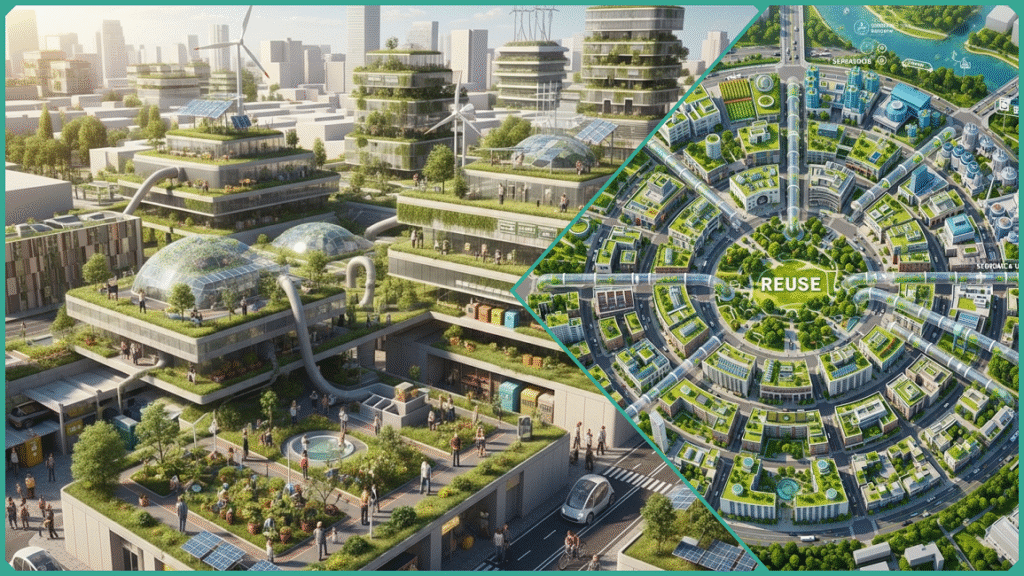How Circular Economy & Urban Planning are Reshaping Cities
Estimated reading time: 17 minutes
Cities around the globe are at a transformative crossroads as they face unprecedented pressures from rapid urbanization, resource depletion, and climate change. The traditional linear model of consumption — take, make, dispose — is no longer sustainable for urban centers that consume over 75% of natural resources, generate over 50% of solid waste, and emit up to 60% of greenhouse gases globally.
To effectively counter these complex challenges, the closely intertwined concepts of the circular economy and innovative urban planning are being increasingly adopted and integrated into modern strategies to fundamentally reshape the way cities operate, grow, and sustain their ever-expanding populations over time.
This innovative and forward-thinking approach provides a comprehensive and systematic model through which cities can effectively reinvent themselves. It enables urban areas to circulate resources in a highly efficient manner, significantly reduce or eliminate waste, and actively regenerate natural ecosystems that have been degraded.

At the same time, this model helps create substantial economic and social value, fostering sustainable development and improving the quality of life for all residents. For urban planners, policymakers, environmental advocates, academics, citizens, and business leaders, understanding how circular economy principles blend with urban planning strategies is crucial for fostering resilient, livable cities that can thrive into the future.
Key Concepts and Theories
To fully understand how the circular economy is significantly impacting the field of urban planning, it is essential that we first grasp the foundational principles and key ideas underlying each of these important disciplines.
We will provide a detailed exploration of the core concepts, fundamental theories, and essential frameworks that form the basis of both the circular economy and urban planning. By doing so, we will set the stage for a deeper understanding of the powerful and transformative intersection between these two fields.
Circular Economy Fundamentals
A circular economy is an economic model designed to replace the traditional linear “take-make-dispose” system with a closed-loop approach that eliminates waste and pollution, keeps products and materials in use for as long as possible, and regenerates natural systems.
In urban contexts, this means cities focus on efficient material flows, promoting durability, repairability, and modularity of products and buildings. It incentivizes innovative business models such as product-as-a-service and urban symbiosis, where waste or by-products from one sector become valuable inputs for another, effectively closing resource loops to minimize landfill and resource extraction.
This comprehensive systemic transition significantly enhances urban resilience and overall sustainability by carefully optimizing the use of resources across multiple sectors. It actively reduces various environmental impacts while simultaneously supporting the long-term economic health and stability of urban areas.
Urban Planning in the Circular Context
Traditional urban planning has largely centered on expansion and resource-intensive development, often with short-term economic goals. Circular urban planning reimagines cities as compact, adaptable, and resource-efficient systems that integrate circular economy principles into their physical and social infrastructure. Key elements include:
- Use of durable, recyclable, and renewable construction materials
- Design of buildings and neighborhoods for disassembly and material reuse
- Implementation of integrated waste and water management systems that recover resources and minimize pollution
- Expansion of green infrastructure, such as parks, urban forests, and green corridors, that regenerate ecosystems and enhance biodiversity
- Development of multi-modal low-emission mobility networks promoting shared, electric, and non-motorized transport
- Adoption of smart technologies and data analytics for monitoring and optimizing urban resource flows
This approach also strongly emphasizes the importance of multisectoral collaboration that brings together governments, businesses, citizens, and researchers in a cooperative effort to co-create urban environments that are adaptive, inclusive, and resilient.
By working together collectively, these diverse groups strive to develop and create cities that effectively balance and thoughtfully address a wide range of social, economic, and ecological needs in a harmonious, integrated, and sustainable manner for the benefit of all residents and the environment.
The Circular City
A circular city fully embeds the principles of the circular economy across its governance, infrastructure, business ecosystems, and communities, operating as an interconnected network that fosters continuous resource circulation, waste elimination, and natural regeneration.
In circular cities, local economies thrive by fostering innovation in circular business models, sharing resources, and enhancing community participation. Residents, governments, and enterprises work collaboratively to maintain the value of natural and man-made assets through durable, adaptable, and regenerative design.
For example, circular cities are designed with the goal to:
- Close material loops by maximizing reuse and recycling within municipal systems
- Minimize resource extraction through local production and efficient consumption
- Promote energy self-sufficiency by integrating renewable energy and decentralized distribution
- Foster social equity and community engagement to ensure fair resource access and ownership
- Leverage digital platforms and smart infrastructure to trace materials and optimize urban metabolism
Circular cities provide significantly enhanced environmental quality, greater economic opportunities, and stronger social cohesion, effectively positioning themselves as leading models for sustainable living in the future. These cities focus on resource efficiency, waste reduction, and community engagement, creating a balanced and resilient urban environment that benefits both people and the planet.
This expanded explanation thoroughly synthesizes the comprehensive circular economy framework with practical, real-world urban planning approaches. It highlights in detail how cities can strategically and effectively transition from traditional linear models to more sustainable circular models by operationalizing key principles such as resource efficiency, environmental regeneration, and cross-sector collaboration.
This integration provides a well-defined and strategic pathway specifically designed for urban areas that are seeking to significantly reduce waste, make the most efficient use of available resources, and foster resilient, thriving communities. It achieves this by embracing innovative planning approaches and driving systemic change that addresses core challenges in sustainable urban development.
Current Trends and Developments
Cities all around the world are at the forefront of pioneering innovative and transformative solutions aimed at shifting from a traditional linear economic model to a more sustainable and circular one.
We will delve into the latest trends and developments in this evolving field, showcasing how urban planners, architects, and policymakers are actively implementing the core principles of the circular economy. Their efforts focus on designing and managing urban environments that are not only more resilient and efficient but also regenerative, ensuring long-term sustainability and improved quality of life for city inhabitants.
Leading City Case Studies
Theory is great, but real-world examples are what truly bring a concept to life. We’ll shift from the theoretical to the practical, examining several leading city case studies that demonstrate how urban centers around the world are actively integrating circular economy principles to build more sustainable, resilient, and innovative urban environments.
Amsterdam, Netherlands
Amsterdam stands out as a global pioneer in circular urban development, having conducted the world’s first city-wide circular economy scan in 2015 that mapped material and resource flows. This thorough analysis provided critical insight into economic opportunities and environmental benefits achievable through circular strategies.
Amsterdam’s hallmark initiative, the “Learning by Doing” program, has since launched over 70 projects encompassing circular procurement policies, reuse of construction materials, and development of networks to support local circular supply chains in the building sector.
These efforts led to millions in added economic value and the creation of hundreds of jobs, especially in circular construction and renovation, underlining the financial stability afforded by circular urban planning.
Beirut, Lebanon
In the context of a profound economic crisis and urban challenges, Beirut has adopted circular economy principles to bolster its economic resilience. Resource-efficient strategies, like waste valorization and water recycling, have contributed to enhancing local self-reliance and sustainability.
Beirut’s example serves as an exceptionally valuable and insightful blueprint for many emerging urbanizing regions around the world, including rapidly developing areas such as parts of Nigeria. In these regions, the fast pace of city growth often intersects critically with the urgent need for sustainable development practices that can support long-term urban resilience and environmental health.
Policy Integration and Urban Infrastructure
Governments and municipalities across the globe are increasingly recognizing the circular economy as a crucial and transformative framework essential for achieving long-term urban sustainability. This approach to sustainability is being progressively embedded in multiple aspects of urban planning and development, including:
- Public procurement policies prioritizing products and services that adhere to circular principles
- Land use and zoning regulations promoting mixed-use, high-density developments that maximize resource efficiency
- Investment in circular buildings capable of reducing carbon footprints by up to 50% through innovative reuse of materials and energy-saving designs
- Ambitious “zero waste to landfill” targets, driving transformative waste management and recycling infrastructures
Public-private partnerships (PPPs) remain essential to actualizing these developments, combining resources and expertise across business, government, and community sectors. These collaborations foster innovative circular manufacturing, sustainable fashion initiatives, urban agriculture, and smart, low-carbon mobility networks.
Technology and Data
The digitization of cities plays an instrumental and increasingly pivotal role in significantly accelerating the circular transition process:
- Smart city technologies track resource consumption, waste streams, and energy use in real time, enabling data-driven decisions and policy adjustments
- Material tracing platforms facilitate transparency in supply chains, helping optimize reuse and recycling processes
- Digital tools empower citizens with information on sustainable consumption, participation in sharing economies, and opportunities for waste reduction
- Data analytics guide infrastructural investments and support dynamic sharing of urban assets, such as shared mobility and communal facilities
Collectively, these innovative technological advances empower cities to transform from being merely passive consumers into proactive and dynamic managers of complex circular urban ecosystems. This shift enables urban areas to take a more active role in overseeing and optimizing sustainable resource use and waste management within their environments.
Benefits of the Circular Economy in Urban Planning
The widespread adoption of circular economy principles within urban planning provides a wide array of profound and far-reaching benefits that positively impact environmental, economic, and social dimensions alike, ultimately fostering the development of cities that are more resilient, sustainable, and capable of thriving well into the future.
Environmental Benefits
Embedding circular economy principles in urban planning leads to a dramatic reduction in waste, pollution, and greenhouse gas emissions. Circular practices, such as material reuse, recycling, and resource-efficient design, help cities minimize their ecological footprint and conserve natural resources.
For instance, reducing reliance on virgin materials diminishes habitat destruction and lowers energy-intensive production processes, which are major sources of pollutants. Circular urbanism also promotes the integration of green infrastructure—including parks, green roofs, and urban forests—that actively regenerates biodiversity and improves urban air quality by mitigating pollution and heat island effects.
Further, managing waste through circular strategies like composting and anaerobic digestion reduces methane emissions from landfills, contributing to improved air quality and combating climate change. Overall, circular cities support a regenerative urban metabolism that preserves ecosystem services and fosters clean, healthy living environments.
Economic Benefits
Circular economy-centered urban planning drives job creation in emerging sectors such as recycling, refurbishment, remanufacturing, and sustainable urban agriculture. These sectors not only absorb displaced workers from traditional, resource-extractive industries but also stimulate economic diversification and innovation.
Additionally, circular product and service innovations open new business opportunities around sharing platforms, product-as-a-service models, and circular supply chains. Cities experience significant cost savings by improving resource efficiency and reducing dependency on scarce, often imported raw materials.
Public procurement and urban development that emphasize circular strategies deliver long-term financial returns through energy savings, reduced waste management costs, and enhanced asset lifespan. By fostering local circular economies, municipalities stimulate economic resilience and reduce vulnerability to global supply chain disruptions.
Social Benefits
The social fabric of cities improves markedly through circular urban planning. The creation of healthier living environments with more green spaces, reduced pollution, and better resource management directly enhances citizens’ quality of life. Circular cities foster resilient communities that can better withstand environmental crises like extreme weather and resource shortages.
Moreover, the participatory nature of circular initiatives encourages increased civic engagement, as citizens take active roles in local circular projects, such as community recycling, urban farming, and material sharing schemes. This inclusivity strengthens social cohesion and promotes equitable access to environmental and economic benefits, ensuring that sustainability supports a just and thriving urban society.
These combined benefits illustrate why the shift towards a circular economy in urban planning is a critical pathway for cities seeking to overcome the challenges of rapid urbanization, climate change, and resource scarcity while fostering inclusive growth and sustainable development.
If desired, a table comparing the benefits across environmental, economic, and social categories can be provided for clearer visualization. Adopting circular economy principles in urban planning delivers significant advantages across environmental, economic, and social dimensions, fostering resilient and sustainable cities.
Environmental Benefits
- Dramatic reduction in waste and pollution: Circular strategies minimize landfill use and emissions by promoting reuse, recycling, and resource-efficient design.
- Conservation of natural resources: Reduced dependency on virgin materials lowers habitat destruction and energy-intensive production processes.
- Improved biodiversity: Integration of green infrastructure like parks, green roofs, and urban forests regenerates ecosystems and mitigates urban heat islands.
- Lower greenhouse gas emissions: Circular waste management (composting, anaerobic digestion) reduces methane emissions, enhancing air quality and combating climate change.
Economic Benefits
- Job creation: Growth in recycling, refurbishment, remanufacturing, and urban farming sectors fosters new employment opportunities.
- New business opportunities: Circular product-service systems and sharing platforms stimulate innovation and local economic diversification.
- Cost savings: Enhanced resource efficiency and circular procurement lower material costs and waste management expenses, improving municipal budgets and economic resilience.
Social Benefits
- Enhanced quality of life: Healthier environments with reduced pollution and abundant green spaces improve well-being for urban residents.
- Resilient communities: Circular urban systems strengthen social cohesion and improve capacity to withstand environmental and economic shocks.
- Increased civic engagement: Active participation in circular initiatives fosters inclusivity, equity, and a stronger sense of community.
These numerous and interconnected benefits collectively highlight the immense and transformative potential of the circular economy to foster the development of thriving, resilient, and sustainable cities. By embracing circular principles, urban areas can effectively address and overcome a wide range of future environmental and social challenges, ensuring long-term prosperity and well-being for their communities.
Call to Action for Circular Economy and Urban Planning
Understanding is undoubtedly the crucial first step in any meaningful process, but it is the decisive action that ultimately creates real, lasting change. This call to action offers clear, practical, and actionable steps tailored for a wide variety of audiences, empowering you to transition from being a passive observer to becoming an engaged, active participant in the vital work of building the sustainable, resilient cities of tomorrow.
For Engaged Citizens
Start by sparking conversations in local communities about the benefits and practices of the circular economy. Advocate for your municipal leaders to enact and support policies that promote circular economy initiatives, such as recycling programs, green public procurement, and waste reduction targets.
Support and patronize local businesses that prioritize sustainable production, reuse, and circular models, helping build a robust circular marketplace. Consider participating in community workshops, repair cafes, and circular economy events to spread awareness and action.
Using available technology platforms and local incentive programs can also boost engagement and impact. Empowered citizens are foundational agents of change, driving urban sustainability from the ground up.
For Urban Planners and Policymakers
Dive into comprehensive circular economy toolkits and frameworks designed specifically for urban contexts to integrate circularity in planning and governance. Embed circular principles into land use planning, resource management, infrastructure development, and public procurement processes.
Facilitate multi-stakeholder partnerships among government agencies, private sector players, academia, and civil society to foster innovation and systemic change. Leverage participatory approaches that engage communities and businesses in co-designing circular solutions, ensuring policies are equitable and feasible.
Place a strong emphasis on prioritizing investments in circular infrastructure, including essential facilities like advanced material recovery centers, expansive green public spaces, and innovative smart resource monitoring systems, to effectively foster and develop vibrant, sustainable living circular cities that thrive on resource efficiency and environmental harmony.
For Business Leaders and Innovators
Explore and adopt circular business models that reduce waste and extend the lifecycle of products and materials through refurbishment, remanufacturing, and product-as-a-service approaches. Invest in circular supply chains that optimize resource use, reclaim waste streams, and build local material symbiosis networks.
Collaborate with city governments, urban planners, and communities to co-create sustainable, resilient urban ecosystems where circular innovations align with municipal goals and citizen needs. Utilize digital tools and data analytics to track material flows and demonstrate impacts, strengthening your leadership in sustainability while accessing new revenue streams and customer bases.
Taking these actionable steps according to one’s specific role not only significantly advances the principles of the circular economy but also helps to build a more inclusive, sustainable, and thriving urban future where people, planet, and profit can coexist harmoniously and support one another in a balanced way.
Encouraging thoughtful reflection and active participation across every level of society—from individual citizens and local communities to policymakers and various businesses—is essential to fully unlocking and realizing the immense potential that circular cities can offer.
FAQs
What is the circular economy?
The circular economy is an economic model designed to eliminate waste and continuously use resources through practices like reuse, repair, refurbishment, recycling, and regeneration. It replaces the traditional linear “take-make-dispose” approach with a restorative system that keeps products and materials in use for as long as possible while regenerating natural systems. This approach aims to reduce pollution, conserve resources, and create sustainable economic growth.
How does urban planning influence a city’s circular economy?
Urban planning shapes how cities use space, infrastructure, and resources. When embedded with circular economy principles, urban planning ensures buildings, transportation, waste management, and energy systems operate efficiently and sustainably. It promotes durable, adaptable infrastructure, integrated waste and resource recovery, green public spaces, and low-emission transport networks that together enable circular flows of materials and energy within urban environments.
What are examples of circular economy projects in cities?
Examples include Amsterdam’s circular construction tenders that reuse building materials and circular procurement policies. Other projects involve urban food waste composting programs, smart shared mobility systems reducing emissions, and public-private partnerships to foster local material reuse and recycling networks. Globally, circular economy initiatives cover sectors like construction, fashion, manufacturing, and municipal services.
How can the circular economy reduce city greenhouse gas emissions?
Circular economy reduces emissions by minimizing raw material extraction and manufacturing impacts, promoting renewable energy, enabling product and material reuse, and supporting sustainable transport like shared electric mobility and walking infrastructure. By closing resource loops and improving urban efficiency, circular practices significantly cut carbon footprints and help cities meet climate goals.
What challenges exist in implementing the circular economy in cities?
Challenges include regulatory hurdles, limited awareness and expertise, upfront financial costs, technological constraints, and the complexity of coordinating multiple stakeholders like governments, businesses, and citizens. Overcoming these barriers requires strategic policies, cross-sector collaboration, capacity building, and fostering innovation ecosystems that support circular transitions.
In Conclusion
The symbiotic relationship between circular economy principles and urban planning is fundamentally transforming cities into models of sustainability, resilience, and economic opportunity. Amsterdam exemplifies this transformation, having pioneered a city-wide circular economy scan in 2015, followed by strategic programs such as “Learning by Doing.”
This pragmatic approach integrates circularity into infrastructure, procurement, policy, and community engagement, unlocking vast environmental benefits, including substantial CO2 reduction, economic gains through millions in added value and hundreds of green jobs, and social improvements via inclusive participation and healthier urban environments.
Amsterdam’s ambitious roadmap, guided by Kate Raworth’s “City Doughnut” economic model, targets 100% circularity by 2050. The city’s focus on three critical sectors—food and organic waste, consumer goods, and the built environment—illustrates a holistic system change that other cities can emulate.
Through innovative public-private partnerships, digital monitoring tools, and citizen engagement, Amsterdam continues to evolve as a global leader, sharing best practices to accelerate circular urbanism worldwide.
As urban populations grow and environmental pressures mount, the imperative for adopting circular city models becomes clearer: building thriving cities grounded in renewal, collaboration, and innovation. For citizens, urban planners, policymakers, and business leaders alike, embracing the circular economy and urban planning is a compelling, actionable path towards healthier, more equitable, and prosperous urban futures.
Cities progressing on this path prove that sustainable transformation is possible—not just in theory, but in practice—demonstrating that regenerative urbanism is essential for the well-being of both people and the planet.






